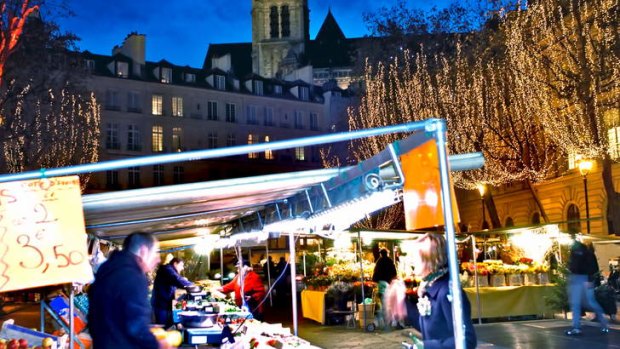
Something special ... artisan traders at the markets in Le Marais.Credit: Alamy
Julietta Jameson finds a neighbourhood to watch beside the Seine.
Le Marais is the Paris we non-Parisians sigh with envy about: narrow cobblestone streets and quaint cafes, traditional artisan food stores, exquisite boutiques and lots of edgy galleries - all wrapped up in a pastel-hued, antiquarian architectural landscape.
It's hard to believe that in the 1970s, Le Marais (which translates as the marsh) was earmarked to be razed. The late-20th-century craze for modernity extended its tentacles into this old and beautiful district of Paris, nestled on the right (northern) bank of the Seine. Thank goodness for Paris's intellectuals, who mounted a campaign to save the neighbourhood. Today, it's a wonderland of urban Frenchness.
That, of course, means that Le Marais teems with tourists every day. But one of its endearing qualities is its ability to retain little secrets. There are beaten paths here, but step a block away from them and there are places that mostly only the locals know.
We ventured into Village Saint-Paul on a walking tour with one such local. Our guide, Alex, of Discover Walks, grew up here and relishes introducing small tour groups to the district's hidden gems.
One of his favourites is a monthly bric-a-brac market. But even if your visit doesn't coincide with the market, the shopping is terrific at Village Saint-Paul, particularly for those seeking authentic, unique or unusual souvenirs.
It is also an amazing microcosm of Parisian history. A nunnery was built in the village in 630; Charles V built a royal residence in the area in 1360; in the 1600s, Henry IV established Place Royale, a grand square within the village where royal celebrations and jousting tournaments were staged.
The wealthy and well connected followed and built houses in Le Marais. They were all of a particular style that featured interior courtyards. Numerous examples of the houses can be seen within Village Saint-Paul.
The houses fell out of fashion in the 19th century as the well-heeled moved to Faubourg Saint-Germain on the left (southern) bank of the Seine. It later became home to many of Paris's Jewish community. The impact of the world wars took a toll on Le Marais, and for decades it was a slum. Amazingly, much of Village Saint-Paul was without running water as recently as 1970.
French neighbourhood rehabilitation authorities finally stepped in and saved Le Marais and Village Saint-Paul - ensuring this pearl of Parisian life sits waiting to be discovered by those who look for it.
Julietta Jameson travelled courtesy of Accor Hotels and Qantas.
Trip notes
Getting there
From April, Qantas will fly to Paris (CDG) via its new gateway, Dubai. The airline flies to London via Singapore. From London, take the Eurostar to Paris. eurostar.com.
Staying there
The upmarket Pullman Paris Montparnasse is a four-star hotel near the Montparnasse Metro station. It provides easy access to the city. 19 Rue Commandant Rene Mouchotte, accorhotels.com.
Touring there
Discover Walks conducts daily tours in Paris. They are free — unless participants wish to pay their guide what they think the experience is worth. The Trendy Marais walk starts at 2.30pm each day. discoverwalks.com.
Village Saint-Paul, which dates to the 16th century, is in the heart of the trendy Marais neighbourhood, an area rich in history and culture. The village is accessible by a maze of passages under the arches near Saint Paul's Church and between the bustling dual carriageways of the historic Rue de Rivoli and the right (northern) bank of the Seine.
Village Saint-Paul is an ideal place to discover unusual objects among the 200 or so antique dealers and designers who open their doors to the public. From relics of the Middle Ages to designs from the '70s, there's something for everyone. Feel free to negotiate prices and initiate discussions with exhibitors.
Near the Village Saint-Paul are the remains of the Walls of Philippe Auguste, built under the orders of the king of the same name in the 11th century. The enclosure, around the then boundaries of Paris, was built to help defend the city against invaders.
Sign up for the Traveller Deals newsletter
Get exclusive travel deals delivered straight to your inbox. Sign up now.